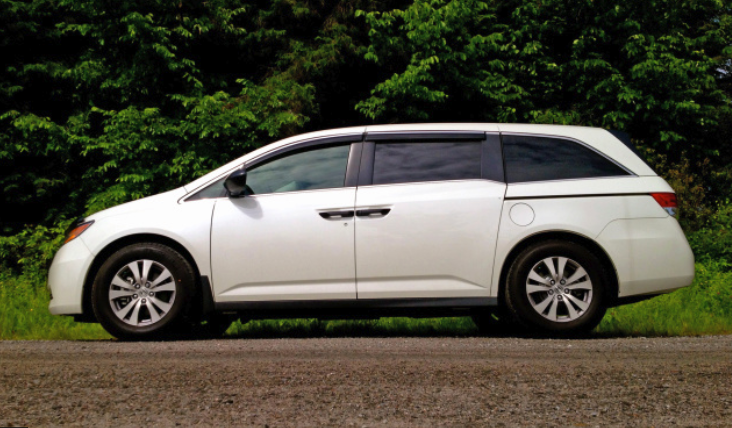Road Test: 2015 Honda Odyssey SE

Story and photo by John LeBlanc
On the rarest of occasions, you can find a new vehicle that is so fundamentally right, so well executed in its mission, you don’t have to pop for the loaded model. Such is the case with the 2015 Honda Odyssey, a minivan that simply does its job, and does it well.
Honda’s minivan needs little introduction. The front-wheel-drive family machine has been around longer than some of the new parents that are buying minivans these days. The first Honda three-row/seven-seater in the mid-1990s was essentially a tall wagon based off a Honda Accord sedan chassis. But because the Odyssey was so well received, and minivans were hotter than Backsteet Boys concert tickets, Honda took the chance and created a North American-market-only model for 1999. That second-gen Odyssey was much larger, had six-cylinders instead of four, borrowed the Chrysler minivan concept of sliding side doors, and added one more squab in the third row for seating for eight.
And for many minivan buyers, the upgrades worked. Here we are 16 years and two generations later, and the Odyssey has remained much the same, even after minivans from Ford, General Motors and Nissan have gone the way of 1990s boy bands as buyers flock to crossovers. So how does the current Odyssey stack up in a depleted minivan segment?
All-new in 2011, Honda hasn’t felt the need to offer any substantial updates to its front-wheel-drive, eight-passenger Odyssey. While you can get a 2015 Dodge Grand Caravan starting at $21,690 (all prices include freight and pre-delivery inspection fees), the more refined and sophisticated Honda minivan starts at $32,119, similar to the Toyota Sienna and Kia Sedona. If you want/need your minivan to feel like a luxury sedan, you can pay as much as $44,179 for a topline Odyssey Touring, which adds such minivan exotica as the world’s first in-car vacuum, voice-activated navigation and a wide-screen DVD system.
Because all versions of Honda’s minivan come with the same 248 horsepower and 250 pound-feet of torque V6 and six-speed automatic transmission combo, paying almost $45K doesn’t get you a bigger, faster or more economical Odyssey. Just look at my relatively cost-effective $34,169 Odyssey SE tester.
Over the base, seven-seat LX, the SE adds one more seat in the second row that can be removed or flipped-up (subsequently, you also get five instead of four Lower Anchors and Tethers), one-inch larger, 17-inch alloy wheels, and a handy centre console with storage and “flip-up trash bag ring”.
The ability of the Odyssey to play many roles is one of the Honda’s key attractions. So if you’re the type of minivan shopper that gets hot and bothered when reading features like “flip-up trash bag ring”, the practical and functional Odyssey may be the supermodel minivan of your fantasies.
As a pure hauler, the Honda offers more interior room than the Kia, if not as accommodating as the more voluminous Toyota. If you don’t need three-passenger/second-row seating, just remove the Odyssey’s middle seat for easier access to the third row. Plus, the Honda’s third-row seats smoothly fold into the floor to create a flat cargo hold. And with every seat in place, there’s plenty of room for up to eight passengers.
While said passengers are well taken care of in the Odyssey, drivers are catered to as well. And, relative to its rivals, the Honda continues to be the most rewarding to drive when the kids aren’t on-board. The Odyssey’s steering delivers more feedback than the Sienna and Sedona, with a rear suspension that nicely limits body roll. Where the Toyota feels wobbly when pressed hard into corners, the Honda feels relatively planted and firm.
Compared to the six-cylinder gas engines in the Sienna and Sedona, the Odyssey’s V6 is slightly down on horsepower. However, it offers more useful torque, which delivers smoother launches when you plant your right foot. And whether you’re paying $30K or $45K, all Odysseys are rated the same at the pumps: 12.3 litres per 100 kilometres in the city, 8.5 on the highway. During my time with the Honda, in mainly urban driving, I saw an indicated average of 10.5 L/100 km.
As family-friendly and (relatively) fun-to-drive as my Odyssey SE was, there are a few items I’d like to see Honda address.
First off, a redesign of the second-row seating hardware would make the Honda even more flexible. Not only does it take two adults and too much time to remove the seats (they do not fold into the floor, like the third row), the comfort of the small middle seat has always been in question. Plus, I prefer the simpler and more intuitive central dash design and controls of the Sedona over the Odyssey’s hard-to-fathom dual-screen setup.
Still, as I wrote from the outset, from the straightforward LX to the luxurious Touring model, the 2015 Honda Odyssey’s basic formula makes it a solid choice for minivan buyers. Its road manners will keep the driver happy. And there’s plenty of room for eight passengers and their gear, something most midsize crossovers cannot claim.





![[del.icio.us]](https://www.straight-six.com/wp-content/plugins/bookmarkify/delicious.png)
![[Digg]](https://www.straight-six.com/wp-content/plugins/bookmarkify/digg.png)
![[Facebook]](https://www.straight-six.com/wp-content/plugins/bookmarkify/facebook.png)
![[Google]](https://www.straight-six.com/wp-content/plugins/bookmarkify/google.png)
![[Reddit]](https://www.straight-six.com/wp-content/plugins/bookmarkify/reddit.png)
![[StumbleUpon]](https://www.straight-six.com/wp-content/plugins/bookmarkify/stumbleupon.png)
![[Twitter]](https://www.straight-six.com/wp-content/plugins/bookmarkify/twitter.png)
![[Email]](https://www.straight-six.com/wp-content/plugins/bookmarkify/email.png)